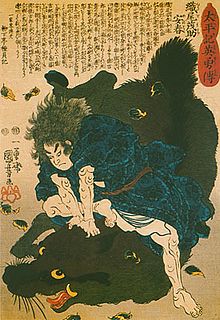Horio Yoshiharu: Difference between revisions
m Substing templates: {{Japanese name}} per WP:Templates for discussion/Log/2020 September 4#Template:Arabic name. Report errors at User talk:AnomieBOT/TFDTemplateSubster. |
Tags: Mobile edit Mobile web edit |
||
| Line 5: | Line 5: | ||
==Career== |
==Career== |
||
After seeing Yoshiharu wrestling a wild boar, [[Toyotomi Hideyoshi]] brought Yoshiharu into his service. |
After seeing Yoshiharu wrestling a wild boar, [[Toyotomi Hideyoshi]] brought Yoshiharu into his service. Yoshiharu served Hashiba Hideyoshi (Toyotomi Hideyoshi) when [[Oda Nobunaga]] [[Siege of Inabayama Castle|attacked Inabayama Castle]] in 1567.<ref>{{cite book|last1=Turnbull|first1=Stephen|title=The Samurai Sourcebook|date=1998|publisher=Cassell & Co|location=London|isbn=9781854095237|page=41}}</ref> |
||
When Hideyoshi attacked [[Takamatsu Castle (Bitchū)|Bitchū Takamatsu Castle]], Yoshiharu conducted an inquest into the death of [[Shimizu Muneharu]]. |
In 1582, after the [[Battle of Tenmokuzan]], he executed [[Oyamada Nobushige]], when Nobushige went to the Oda clan camp. When Hideyoshi attacked [[Takamatsu Castle (Bitchū)|Bitchū Takamatsu Castle]], Yoshiharu conducted an inquest into the death of [[Shimizu Muneharu]]. |
||
Horio was involved in various battles such as the [[Battle of Yamazaki]]<ref name="TH">{{cite book|last1=Turnbull|first1=Stephen|title=Toyotomi Hideyoshi|url=https://archive.org/details/toyotomihideyosh00turn|url-access=limited|date=2010|publisher=Osprey Publishing|location=Oxford|isbn=9781846039607|page=[https://archive.org/details/toyotomihideyosh00turn/page/n30 29]}}</ref> and shined as a retainer of Hideyoshi. At the [[Battle of Shizugatake]] in 1583, he killed [[Saito Toshikazu]] after he attempt to scroll past Hideyoshi's lines. |
Horio was involved in various battles such as the [[Battle of Yamazaki]] in 1582<ref name="TH">{{cite book|last1=Turnbull|first1=Stephen|title=Toyotomi Hideyoshi|url=https://archive.org/details/toyotomihideyosh00turn|url-access=limited|date=2010|publisher=Osprey Publishing|location=Oxford|isbn=9781846039607|page=[https://archive.org/details/toyotomihideyosh00turn/page/n30 29]}}</ref> and shined as a retainer of Hideyoshi. At the [[Battle of Shizugatake]] in 1583, he killed [[Saito Toshikazu]] after he attempt to scroll past Hideyoshi's lines. |
||
In 1590, Hideyoshi awarded him 120,000 [[koku]] at Hamamatsu, [[Tōtōmi Province]] because of the credit for the [[Siege of Odawara (1590)|siege of Odawara]]. Horio Yoshiharu, [[Nakamura Kazuuji]] and [[Ikoma Chikamasa]] were appointed the three ''chūrō'' by Hideyoshi in his last years, and participated in the [[Toyotomi administration]]. |
|||
| ⚫ | |||
| ⚫ | |||
In 1600, Yoshiharu took part in Ieyasu's force. He killed [[Kaganoi Shigemochi]], who killed [[Mizuno Tadashige]] on August 27 at Chiryu, [[Mikawa Province]], but was injured by Shigemochi. Because of that, he could not take part in the [[Battle of Sekigahara]] on October 21. However, Ieyasu gave him 240,000 koku at Toda, [[Izumo Province]] after the battle, because Yoshiharu had killed Shigemochi and Tadauji had substituted the performance of exploits at the battle on his behalf. |
In 1600, Yoshiharu took part in Ieyasu's force. He killed [[Kaganoi Shigemochi]], who killed [[Mizuno Tadashige]] on August 27 at Chiryu, [[Mikawa Province]], but was injured by Shigemochi. Because of that, he could not take part in the [[Battle of Sekigahara]] on October 21. However, Ieyasu gave him 240,000 koku at Toda, [[Izumo Province]] after the battle, because Yoshiharu had killed Shigemochi and Tadauji had substituted the performance of exploits at the battle on his behalf. |
||
Revision as of 07:42, 30 December 2020


Horio Yoshiharu (堀尾 吉晴, 1542 – July 26, 1611) was a Japanese daimyō during the Azuchi–Momoyama and Edo periods. He was appointed to the position of one of three chūrō (arbiters) by Toyotomi Hideyoshi and was the first leader of the Matsue clan. He was also known as Horio Mosuke (堀尾 茂助).
Career
After seeing Yoshiharu wrestling a wild boar, Toyotomi Hideyoshi brought Yoshiharu into his service. Yoshiharu served Hashiba Hideyoshi (Toyotomi Hideyoshi) when Oda Nobunaga attacked Inabayama Castle in 1567.[1]
In 1582, after the Battle of Tenmokuzan, he executed Oyamada Nobushige, when Nobushige went to the Oda clan camp. When Hideyoshi attacked Bitchū Takamatsu Castle, Yoshiharu conducted an inquest into the death of Shimizu Muneharu.
Horio was involved in various battles such as the Battle of Yamazaki in 1582[2] and shined as a retainer of Hideyoshi. At the Battle of Shizugatake in 1583, he killed Saito Toshikazu after he attempt to scroll past Hideyoshi's lines.
In 1590, Hideyoshi awarded him 120,000 koku at Hamamatsu, Tōtōmi Province because of the credit for the siege of Odawara. Horio Yoshiharu, Nakamura Kazuuji and Ikoma Chikamasa were appointed the three chūrō by Hideyoshi in his last years, and participated in the Toyotomi administration.
Yoshiharu switched his allegiance to Tokugawa Ieyasu after the death of Hideyoshi. In 1599, he transferred responsibility as head of the family to his son, Horio Tadauji, and was given 50,000 koku as a domain to live after retirement at Fuchu, Echizen Province.
In 1600, Yoshiharu took part in Ieyasu's force. He killed Kaganoi Shigemochi, who killed Mizuno Tadashige on August 27 at Chiryu, Mikawa Province, but was injured by Shigemochi. Because of that, he could not take part in the Battle of Sekigahara on October 21. However, Ieyasu gave him 240,000 koku at Toda, Izumo Province after the battle, because Yoshiharu had killed Shigemochi and Tadauji had substituted the performance of exploits at the battle on his behalf.
In 1604, Yoshiharu's son, Tadauji who had succeeded him as head of his house died young, and his grandchild, Horio Tadaharu succeeded to a house. Tadaharu was so young (9 years old) that Yoshiharu ruled as a godfather until his own death. Yoshiharu was popular and was so calm that he was called Hotoke no Mosuke (仏の茂助), which means that Yoshiharu was a saint of a man.
The family temple of the Horio clan is Shunkō-in, in Hanazono, Ukyo District, Kyoto Prefecture.
External links
References
- ^ Turnbull, Stephen (1998). The Samurai Sourcebook. London: Cassell & Co. p. 41. ISBN 9781854095237.
- ^ Turnbull, Stephen (2010). Toyotomi Hideyoshi. Oxford: Osprey Publishing. p. 29. ISBN 9781846039607.
